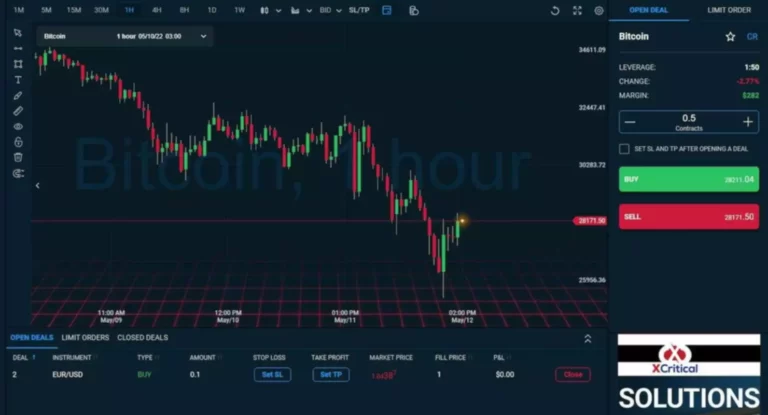If the price action confirms the levels, traders may enter positions or adjust existing positions accordingly. Investors use Fibonacci projections as a complementary tool along with other technical analysis indicators and fundamental analysis to make informed decisions about their investments. It is important to note that Fibonacci projections are not a guarantee of future market performance, but rather a tool to help traders make informed decisions based on past market behavior. This example shows the rise in the price of Crude Oil West Texas (also called WTI Crude Oil), which is part of the commodities market.
These Fibonacci retracement lines can then be used to identify areas where the price may potentially experience support or resistance. If the price action of the asset is trending upwards, the Fibonacci fan can be used to identify potential levels of support. Conversely, if the price action is trending downwards, the Fibonacci fan can be used to identify potential levels of resistance.
Together they provide more reliable signals for entering and exiting a trade. It doesn’t matter if you are trading with or against the trend; use Fibonacci retracement to find a place where an asset may bounce or reverse. Also, these lines are helpful in placing a Stop Loss and a Take Profit. Of course, it is more reliable to look for a confluence of signals how to use the fibonacci retracement indicator (i.e. more reasons to take action on a position). Don’t fall into the trap of assuming that just because the price reached a Fibonacci level the market will automatically reverse. While the indicator is simple to use and works well under trendy market conditions, it is better to use it in conjunction with other indicators to confirm trade signals.
In addition to the disclaimer below, the material on this page does not contain a record of our trading prices, or an offer of, or solicitation for, a transaction in any financial instrument. IG accepts no responsibility for any use that may be made of these comments and for any consequences that result. No representation or warranty is given as to the accuracy or completeness of this information. Consequently any person acting on it does so entirely at their own risk. Any research provided does not have regard to the specific investment objectives, financial situation and needs of any specific person who may receive it. It has not been prepared in accordance with legal requirements designed to promote the independence of investment research and as such is considered to be a marketing communication.
Downtrend
Market trends are more accurately identified when other analysis tools are used with the Fibonacci approach. The market did try to rally, and stalled below the 38.2% level for a bit before testing the 50.0% level. Price pulled back right through the 23.6% level and continued to shoot down over the next couple of weeks. Here are 3 ways you can get fresh, actionable alerts every single day. What is significant about this pattern, however, is that the ratio of any number to the next one in the sequence tends to be 0.618. Similarly, you can also calculate the 50% Fibonacci level, though it isn’t “technically” considered part of the sequence.
The core approach to Fibonacci retracement is a fairly rudimentary form of technical analysis that can be made more complex using different methods. After the down move, the stock attempted to bounce back retracing back to Rs.162, which is the 61.8% Fibonacci retracement level. The ratio of 1.618 is considered as the Golden Ratio, also referred to as the Phi. The ratio can be found in the human face, flower petals, animal bodies, fruits, vegetables, rock formation, galaxy formations etc.
Trading platforms
Fibonacci retracements are useful tools that help traders identify support and resistance levels. With the information gathered, traders can place orders, identify stop-loss levels, https://www.xcritical.in/ and set price targets. Although Fibonacci retracements are useful, traders often use other indicators to make more accurate assessments of trends and make better trading decisions.
- Technical analysis focuses on market action — specifically, volume and price.
- Together they provide more reliable signals for entering and exiting a trade.
- These horizontal lines are used to identify possible price reversal points.
- Fibonacci retracement and extension analysis helps traders locate support and resistance levels on asset price charts.
- You’ll also need to keep in mind that past performance doesn’t guarantee future returns.
The Fibonacci ratios are percentages of a chosen price range that determine the support and resistance levels of a price movement. The Fibonacci ratios were derived from the Fibonacci numbers – a sequence of numbers where each number is the sum of the previous two. If you divide a Fibonacci number by the next number, the result will be 0.618 (61.8%). If you divide the same number by the second number to its right, you’ll get 0.382 (38.2%), and then 0.236 (23.6%). It turns out that these ratios along with 50% represent the support and resistance levels in price movements, so they’re used to identify the Fibonacci retracement levels.
Although we are not specifically constrained from dealing ahead of our recommendations we do not seek to take advantage of them before they are provided to our clients. Like with retracements, extensions can be points where a price reversal may occur. They are useful in areas where other methods of identifying an asset’s support or resistance are not successful. Like with day trading, traders can use this information to set price targets around bullish points, or stop-loss limits at bearish levels. Fibonacci retracements are trend lines drawn between two significant points, usually between absolute lows and absolute highs, plotted on a chart.
The Fibonacci Retracements
Fibonacci retracement levels are considered a predictive technical indicator as they are designed to forecast future changes in the market. The Fibonacci Trailing Stop indicator creates a Trailing Stop, based on Fibonacci levels which are retrieved from the latest swing high & low . 🔶 USAGE The Fibonacci Trailing Stop can indicate the current trend direction. The “Fibonacci Ranges” indicator combines Fibonacci ratio-derived ranges (channels), together with a Fibonacci pattern of the latest swing high/low.
It’s relatively simple to pick up how to use Fibonacci retracements, making them popular among novice traders. In technical analysis, Fibonacci retracement levels indicate key areas where a stock may reverse or stall. Usually, these will occur between a high point and a low point for a security, designed to predict the future direction of its price movement. Fibonacci retracement levels can be used in charts as a way to find the most opportune moment to enter a trade. The most common way to apply this tool is to see whether the price retraces to one of the Fibonacci levels after following a steady trade.
It’s a beautiful theory or concept that remarkably worked pretty well for traders for over five decades (investors started using Fibonacci numbers in the early 70s of the previous century). Fibonacci extensions are another way to make the sequence more complex and increase potential outcomes. I’ve encircled two points on the chart, at Rs.380 where the stock started its rally and at Rs.489, where the stock prices peaked. The inverse of the golden ratio (1.618) is 0.618, which is also used extensively in Fibonacci trading.
Other popular technical indicators that are used in conjunction with Fibonacci levels include candlestick patterns, trendlines, volume, momentum oscillators, and moving averages. A greater number of confirming indicators in play equates to a more robust reversal signal. Fibonacci retracements are often used as part of a trend-trading strategy. In this scenario, traders observe a retracement taking place within a trend and try to make low-risk entries in the direction of the initial trend using Fibonacci levels. Traders using this strategy anticipate that a price has a high probability of bouncing from the Fibonacci levels back in the direction of the initial trend. When these indicators are applied to a chart, the user chooses two points.
If used correctly, Fibonacci retracements and ratios can help traders to identify upcoming support and resistance levels based on past price action. Fibonacci extensions are technical analysis tools used to identify potential levels of support and resistance levels in financial markets. The extensions are based on the Fibonacci sequence, which is a series of numbers where each number is the sum of the two preceding ones (0, 1, 1, 2, 3, 5, 8, 13, 21, etc.).
Indicators, Strategies and Libraries
Similar consistency can be found when any number in the Fibonacci series is divided by a number two places higher. Click on the Swing Low and drag the cursor to the most recent Swing High.
By plotting these numbers on a chart, traders can identify key levels where the asset price may experience resistance or support. The most commonly used Fibonacci retracement levels are 38.2%, 50%, and 61.8%. The Fibonacci retracement level gives technical traders a good edge in the market. The Fibonacci retracement tool is one of the most common trading tools on charting software – MT4. Fibonacci retracements are a popular form of technical analysis used by traders in order to predict future potential prices in the financial markets.


